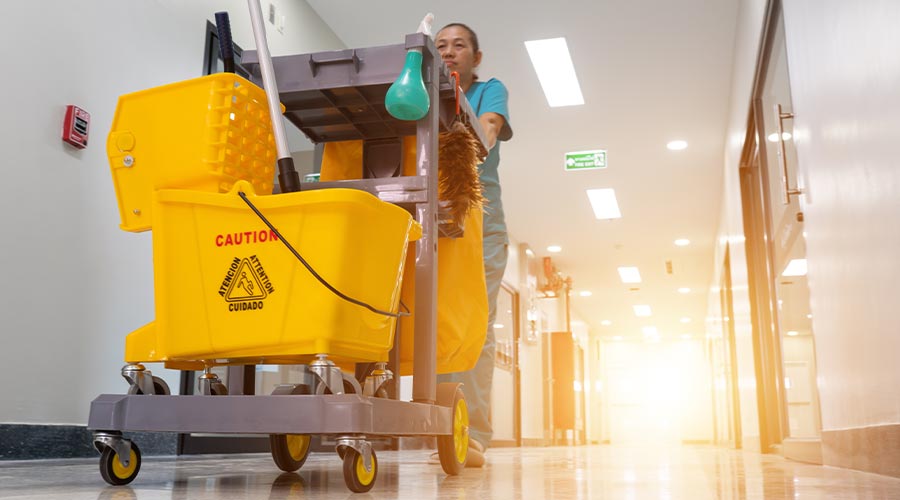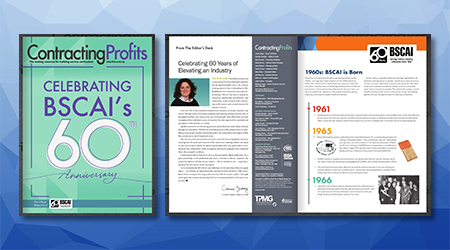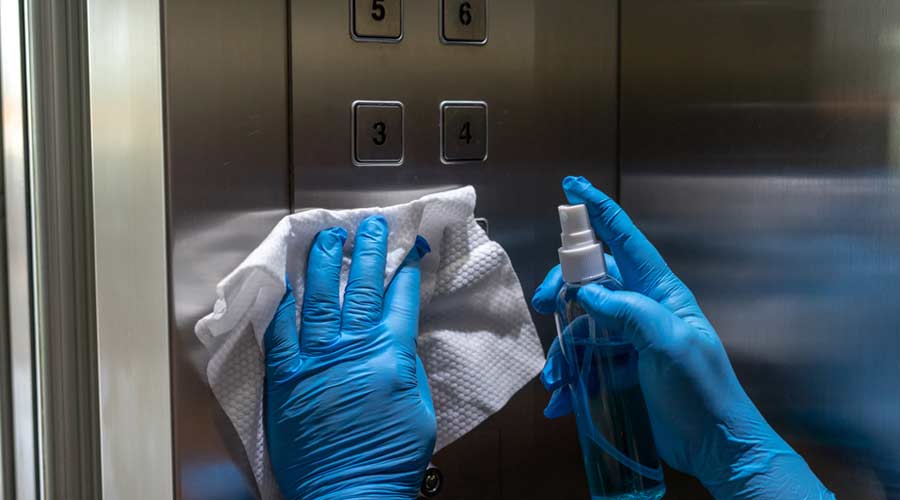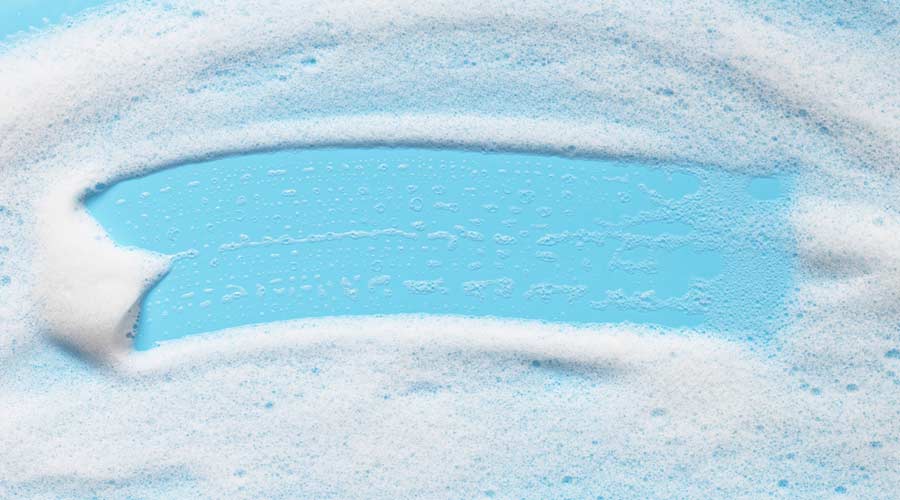
While automation may consistently grab industry headlines and attention, the need for human-propelled manual tools, particularly mops and mopping carts, remain an important component of daily cleaning and should be included in sales pitches.
Robotic floor scrubbers are effective for covering large, open environments like gymnasiums, but they are not necessarily well-suited for detailed work that indoor environments require. Areas with numerous corners, edges, or irregular surfaces require a solution with a bit more nuance, which is why the emergence of ergonomically minded mopping carts offers significant benefits to cleaning operations.
"Until we have a robot that fully replaces the human, hand tools will remain essential," says one industry director of sales. "Even then, the robots will probably need to be equipped with hand tools."
With the mention of the word mop, it's hard not to envision the traditional large yellow bucket full of murky solution, pushed around by a bulky Kentucky mop on a fixed wooden handle. Reality, however, is far from perception. Over the past two decades, particularly with the introduction of microfiber flat mops and adjustable mop handles, mopping technology has become lighter and more efficient, thereby reducing the impact on individuals performing the work.
"Ergonomic poles help prevent carpal tunnel and constant bending risk," the director of sales says. "And we need to think about not just reaching high but reaching low. Why should end user customers bend all the way over just to clean the bottom of a glass panel? Extending the reach helps protect custodians from unnecessary strain."
It's no secret that custodial work is physically demanding. Repetitive tasks that can strain the shoulders, back, and wrists are commonplace. Publicly funded studies, such as the Washington State Department of Labor's ongoing Janitorial Workload Study, have linked fast work pace and high physical loads to increased rates of musculoskeletal pain and injury among custodians. Tasks such as mopping require sustained exertion and can involve awkward postures if the tools don't match the worker.
Customers that prioritize ergonomics often experience measurable benefits for their workforce. Investing in ergonomics not only safeguards worker health but also builds a more stable and productive custodial workforce. For distributors, highlighting these ergonomic benefits reframes hand tools from a commodity to a workforce investment.
Mop Carts Matter
Mop carts introduce an extra dimension. They support the specialization of labor by centralizing mopping tasks. Carts explicitly designed to address specific cleaning jobs systematically offer unique solutions for improving productivity and overall worker safety. That's because, inherent in their design, they create a crucial productivity concept borrowed from manufacturing best practices known as "kitting."
Although the term "kitting" didn't emerge until centuries later in manufacturing, its seeds were planted in Adam Smith's 1776 classic, “The Wealth of Nations.” In his famous pin factory example, Smith observed that productivity increases dramatically by dividing work into specialized tasks, separating tools by specific task, and eliminating the wasted time of shifting between jobs. Kitting applies the same principle: by pre-planning all the tools, supplies, and materials a worker needs before they begin, it eliminates unnecessary motion, reduces delays, and allows people to focus on the task at hand. When done right, kitting reduces wasted motion, cuts setup time, and creates a standardized process.
The best case study for the effectiveness of kitting lies in early American automobile manufacturing, particularly with the Ford Motor Company and its innovative production line. Ford organized all the tools, parts, and supplies needed for a task into a single, ready-to-use setup. Instead of searching for materials or restocking mid-shift, workers begin with everything pre-staged in a consistent order, allowing them to move through tasks without interruption — and to keep the assembly line moving. The concept was later adopted and formalized by Toyota as part of its Toyota Production System (TPS), combining just-in-time inventory, standardized work procedures, and point-of-use part delivery. The success of TPS led to widespread adoption as a best practice for lean manufacturing principles in the 1980s.
How does this all relate to mop cart systems? Mop cart systems are customizable and “kittable” for work that goes beyond on-the-floor cleaning tasks. They are scalable, adaptable tools that cleaning operations can configure for a variety of specialized cleaning tasks. The ability to kit mop carts for specific functions can significantly reduce wasted motion going back and forth from closets between jobs, and if done correctly, increases the actual time spent cleaning.
“Cart a la carte. That's how I think about it," the director of sales says. "End users want the flexibility to configure carts for their workflow, and that makes them more productive."
When exploring mopping cart systems best suited for customers, it’s important to familiarize oneself with the options that are out there. There are several popular configurations of mopping carts:
Restroom Mopping Cart Systems: These typically feature a mobile, dual-sided mopping system — one side for collecting and wringing soiled solution, one side for applying clean solution with the mop. Popular configurations usually come with a handle that sits slightly above waist level for easy maneuvering throughout the facility and over thresholds. They also provide space for hand tools, such as extendable dusters and long-handled toilet brushes. They are capable of customization with assorted bins and trays for cleaning cloths, trash liners, and spray bottles.
Common Area/Portering Cart Systems: Like restroom mopping systems, this popular configuration includes a dual-sided mopping system, along with clips for various details and corner brushes for accessing hard-to-reach areas. The design is conducive to mopping and detailed cleaning of hallways and lobbies or performing quick policing activities during times of significant occupancy.
Healthcare Mopping Cart Systems: These typically come configured with a changing bucket for clean microfiber mopheads immersed in a disinfectant cleaner, and a separate empty bucket for soiled mopheads after frontline workers move from one patient area to another. This is a cross-contamination prevention strategy that prevents contamination from room to room, keeping the soiled mopheads isolated from other tools and materials on the cart.
As facilities evolve, so too must the carts. According to the industry director of sales, there are a few key trends to watch — most particularly, the allocation of space for janitorial closets in new building design.
"As new buildings are built, they're taking away space," he says. "Tools and carts will have to be more agile."
Compact cart footprints, modular accessories, and collapsible or stackable componentsprovide adaptable solutions to the ongoing space shortage problem. This helps cleaning end users maintain a lean operation without sacrificing important space in their facilities, which is often at a premium.
While automation will continue advancing, manual cleaning systems are far from becoming obsolete. In fact, they're evolving to complement — not compete with — robotics. As the director of sales notes, large robotic scrubbers will likely handle expansive open areas, but detail work still demands human precision.
"Robotics will cover the big spans," he says, "but the hand tools will still be here, guaranteed."
Considering all of this, what should distributors keep in mind when it comes to mop cart systems? Consultative sales. This systems-based approach of mop carts opens the door for consultative sales — bundling carts, mops, and accessories into ready-to-go solutions, rather than piecemeal transactions.
"Distributors who just drop off a mop are leaving value on the table," the industry director of sales says. "The real win is showing how these tools integrate — carts, handles, mop heads — into a system that saves labor hours and keeps workers safe."
Manual systems aren’t relics, they’re precision platforms, and the smartest distributors are selling them that way.
Ben Walker is President of Walker Foundry, a cleaning industry consultancy. A 20-year industry veteran, he writes regularly on the human element of cleaning, elevating custodial operations, and workforce innovation.

 Celebrating BSCAI's 60th Anniversary eBook
Celebrating BSCAI's 60th Anniversary eBook The Down and Dirty on Cleaning in Virus Season
The Down and Dirty on Cleaning in Virus Season How Surfactant Use is Expanding in Commercial Cleaning
How Surfactant Use is Expanding in Commercial Cleaning